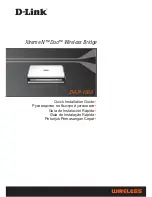
Network Topologies
4-5
4
Infrastructure Wireless Bridge
The IEEE 802.11 standard defines a WIreless Distribution System (WDS) for bridge
connections between BSS areas (access points). The access point uses WDS to
forward traffic on links between units.
The access point supports WDS bridge links on either the 5 GHz (802.11a) or
2.4 GHz (802.11b/g) bands and can be used with various external antennas to offer
flexible deployment options.
Up to six WDS bridge links can be specified for each unit in the wireless bridge
network. One unit only must be configured as the “root bridge” in the wireless
network. The root bridge should be the unit connected to the main core of the wired
LAN. Other bridges must configure one “parent” link to the root bridge or to a bridge
connected to the root bridge. The other five available WDS links can be specified as
“child” links to other bridges. This forms a tiered-star topology for the wireless bridge
network.
When using WDS on a radio band, only wireless bridge units can associate to each
other. Wireless clients can only associate with the access point using a radio band
set to access point or repeater mode.
Wireless Bridge Links
Between Access Points
802.11a Radio
Bridge Link
802.11g Radio
AP Link
802.11a Radio
Bridge Link
802.11g Radio
AP Link
802.11g Radio
AP Link
Root Bridge
Bridge
802.11a Radio
Bridge Link
802.11g Radio
AP Link
Bridge
Bridge
Network
Core
















































